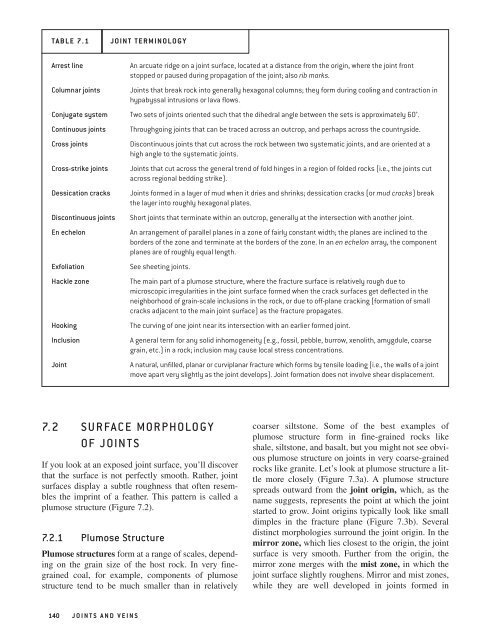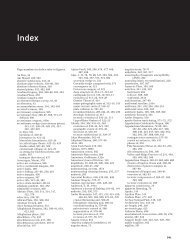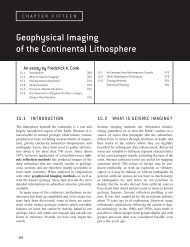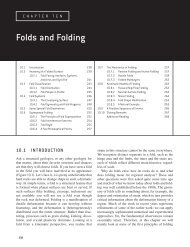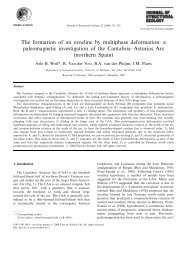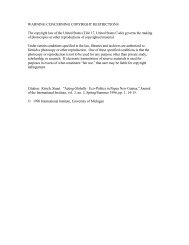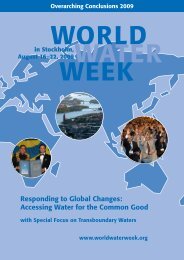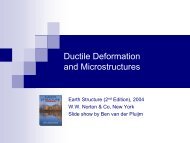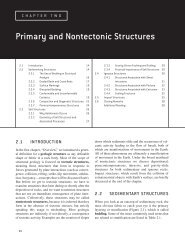Joints and Veins - Global Change
Joints and Veins - Global Change
Joints and Veins - Global Change
- No tags were found...
You also want an ePaper? Increase the reach of your titles
YUMPU automatically turns print PDFs into web optimized ePapers that Google loves.
2917-CH07.pdf 11/20/03 5:10 PM Page 140TABLE 7.1JOINT TERMINOLOGYArrest lineAn arcuate ridge on a joint surface, located at a distance from the origin, where the joint frontstopped or paused during propagation of the joint; also rib marks.Columnar joints<strong>Joints</strong> that break rock into generally hexagonal columns; they form during cooling <strong>and</strong> contraction inhypabyssal intrusions or lava flows.Conjugate system Two sets of joints oriented such that the dihedral angle between the sets is approximately 60°.Continuous joints Throughgoing joints that can be traced across an outcrop, <strong>and</strong> perhaps across the countryside.Cross jointsCross-strike jointsDessication cracksDiscontinuous jointsEn echelonExfoliationHackle zoneHookingInclusionJointDiscontinuous joints that cut across the rock between two systematic joints, <strong>and</strong> are oriented at ahigh angle to the systematic joints.<strong>Joints</strong> that cut across the general trend of fold hinges in a region of folded rocks (i.e., the joints cutacross regional bedding strike).<strong>Joints</strong> formed in a layer of mud when it dries <strong>and</strong> shrinks; dessication cracks (or mud cracks) breakthe layer into roughly hexagonal plates.Short joints that terminate within an outcrop, generally at the intersection with another joint.An arrangement of parallel planes in a zone of fairly constant width; the planes are inclined to theborders of the zone <strong>and</strong> terminate at the borders of the zone. In an en echelon array, the componentplanes are of roughly equal length.See sheeting joints.The main part of a plumose structure, where the fracture surface is relatively rough due tomicroscopic irregularities in the joint surface formed when the crack surfaces get deflected in theneighborhood of grain-scale inclusions in the rock, or due to off-plane cracking (formation of smallcracks adjacent to the main joint surface) as the fracture propagates.The curving of one joint near its intersection with an earlier formed joint.A general term for any solid inhomogeneity (e.g., fossil, pebble, burrow, xenolith, amygdule, coarsegrain, etc.) in a rock; inclusion may cause local stress concentrations.A natural, unfilled, planar or curviplanar fracture which forms by tensile loading (i.e., the walls of a jointmove apart very slightly as the joint develops). Joint formation does not involve shear displacement.7.2 SURFACE MORPHOLOGYOF JOINTSIf you look at an exposed joint surface, you’ll discoverthat the surface is not perfectly smooth. Rather, jointsurfaces display a subtle roughness that often resemblesthe imprint of a feather. This pattern is called aplumose structure (Figure 7.2).7.2.1 Plumose StructurePlumose structures form at a range of scales, dependingon the grain size of the host rock. In very finegrainedcoal, for example, components of plumosestructure tend to be much smaller than in relativelycoarser siltstone. Some of the best examples ofplumose structure form in fine-grained rocks likeshale, siltstone, <strong>and</strong> basalt, but you might not see obviousplumose structure on joints in very coarse-grainedrocks like granite. Let’s look at plumose structure a littlemore closely (Figure 7.3a). A plumose structurespreads outward from the joint origin, which, as thename suggests, represents the point at which the jointstarted to grow. Joint origins typically look like smalldimples in the fracture plane (Figure 7.3b). Severaldistinct morphologies surround the joint origin. In themirror zone, which lies closest to the origin, the jointsurface is very smooth. Further from the origin, themirror zone merges with the mist zone, in which thejoint surface slightly roughens. Mirror <strong>and</strong> mist zones,while they are well developed in joints formed in140 JOINTS AND VEINS


